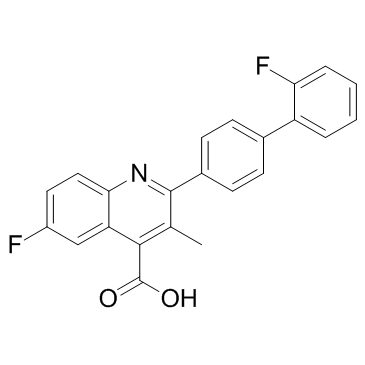96187-53-0
| Name | 6-fluoro-2-[4-(2-fluorophenyl)phenyl]-3-methylquinoline-4-carboxylic acid |
|---|---|
| Synonyms |
Brequinarum [INN-Latin]
6-Fluoro-2-(2'-fluoro-[1,1'-biphenyl]-4-yl)-3-methylquinoline-4-carboxylic acid brequinarum [Latin] 6-Fluoro-2-(2'-fluoro-4-biphenylyl)-3-methyl-4-quinolinecarboxylic acid 6-Fluoro-2-(2'-fluorobiphenyl-4-yl)-3-methylquinoline-4-carboxylic acid 4-Quinolinecarboxylic acid, 6-fluoro-2-(2'-fluoro[1,1'-biphenyl]-4-yl)-3-methyl- Brequinar Brequinar [INN] brequinar potassium Dup 785 BREQUINAR SODIUM |
| Description | Brequinar is a potent inhibitor of dihydroorotate dehydrogenase, with potent activities against a broad spectrum of viruses. |
|---|---|
| Related Catalog | |
| In Vitro | Brequinar reduces virus progeny production by >90%, with EC50 of 17 nM. Brequinar (5 μM) also inhibits other orthopoxviruses, and blocks virus DNA replication. Brequinar does not affect virus early gene expression, but has a severe effect on the late stage of the virus cycle[1]. Brequinar reduces the level of envelope protein production and the viral titer in a dose-dependent manner, with EC50 of 78 nM in the CFI assay. Brequinar (5 μM) inhibits viral RNA synthesis. Brequinar has antiviral effect, but the effect is reversed by pyrimidine. Brequinar-resistant viruses can be selected in cell culture. Brequinar (5 μM) suppresses the luciferase activities from both the WT and NS5 mutant replicons[2]. Brequinar sodium effectively prevents the increase in PyNTP levels with an IC50 of 0.26 μM. Brequinar sodium effectively inhibits cell proliferation with an IC50 of 0.26 μM. Brequinar sodium inhibits autophosphorylation of p56lck with IC50 of 70 μM; inhibition is 39, 41, and 60% for 25, 50, and 100 μM Brequinar sodium, respectively. Brequinar sodium also inhibits the phosphorylation by p56lck of the exogenous substrate, histone 2B, with an IC50 of 70 μM; inhibition is 10, 43, 59, and 86% for 25, 50, 100, and 200 μM Brequinar sodium, respectively. Brequinar sodium inhibits autophosphorylation of p59fyn with an IC50 of 105 μM; inhibition is 0, 17, 48, and 65% for 25, 50, 100, and 200 μM Brequinar sodium, respectively. Brequinar sodium also inhibits the phosphorylation by p59fyn of histone 2B with an IC50 of 20 μM; inhibition is 26, 54, 79, 83, and 84% for 10, 25, 50, 100, and 200 μM Brequinar sodium, respectively[3]. |
| In Vivo | Brequinar sodium-treated (10-20 mg/kg/day) mice has a 31% reduction in percentage of packed cell volume compared with untreated BALB/c mice. Brequinar sodium reduces UTP and CTP levels in bone marrow cells by 30 and 25%, respectively. Brequinar sodium (10-20 mg/kg/day) in combination with uridine (1000-2000 mg/kg/day) prevents anemia, and the hematocrits remain at levels (61-63%) comparable with those of untreated controls[3]. |
| Kinase Assay | Immunoprecipitated p59fyn or p56lck from CTLL-4 cells or LSTRA cells (5×106) is preincubated with various concentrations of BQR in the PTK buffer (50 mM HEPES (pH 7.4), 10 mM MgCl2, and 10 mM MnCl2) on ice for 10 min. Exogenous substrate, histone 2B (2 μg), is added and, after 10 min, the reaction is initiated by addition of 10 μCi [γ-32P]ATP. After incubation at 20°C for 10 min, the reaction mixture is subjected to electrophoresis in a 12.5% SDS-polyacrylamide gel. Phosphorylation of the kinase and the exogenous substrate is analyzed by autoradiography. |
| Cell Assay | The neutral-red uptake assay is used to evaluate cell viability. BSC-40 cells are seeded in 96-well plates in the presence of concentrations of Brequinar ranging from 0.01 μM to 75 μM for 24 h. Control cells are incubated with 0.1% DMSO. Neutral red is methanol/acetic acid-extracted from cells and is quantitated at an absorbance of 490 nm (A490). All measurements expressed the average of four independent assays. |
| Animal Admin | Brequinar is administered once daily by i.p. injection, while uridine is administered twice daily. Mice are bled through the orbital vein using a microhematocrit capillary tube, and the blood is centrifuged for 10 min at 550 × g. The percentage of packed cell volumes is determined with a microhematocrit capillary tube reader. All mice are killed 4 h after receiving their last dose of Brequinar or uridine. |
| References |
| Density | 1.3±0.1 g/cm3 |
|---|---|
| Boiling Point | 550.9±50.0 °C at 760 mmHg |
| Melting Point | 317 °C |
| Molecular Formula | C23H15F2NO2 |
| Molecular Weight | 375.367 |
| Flash Point | 287.0±30.1 °C |
| Exact Mass | 375.107086 |
| PSA | 50.19000 |
| LogP | 6.69 |
| Vapour Pressure | 0.0±1.6 mmHg at 25°C |
| Index of Refraction | 1.645 |
| Hazard Codes | Xi |
|---|---|
| HS Code | 2933499090 |
| HS Code | 2933499090 |
|---|---|
| Summary | 2933499090. other compounds containing in the structure a quinoline or isoquinoline ring-system (whether or not hydrogenated), not further fused. VAT:17.0%. Tax rebate rate:13.0%. . MFN tariff:6.5%. General tariff:20.0% |

